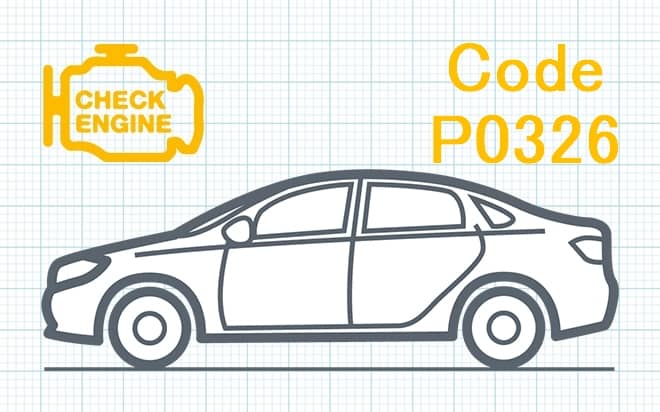
P0326 Knock sensor signal level out of range (sensor 1, bank 1)
Content
P0326 – OBD-II Trouble Code Technical Description
Trouble code P0326 indicates a problem with the knock sensor 1 (bank 1).
What does the fault code mean P0326?
Trouble code P0326 indicates problems with the knock sensor or its signal. This code means that the engine control module (ECM) has detected that the knock sensor reference voltage is outside the manufacturer's specified range. If the knock sensor is not working correctly or its signal is not reliable, it can cause the engine to not operate properly or even cause engine damage.

Possible reasons
Several possible causes for trouble code P0326:
- Malfunctioning Knock Sensor: The knock sensor may be damaged or faulty, resulting in an incorrect or intermittent signal that the ECM cannot interpret correctly.
- Wiring or Connections: Problems with the wiring or connections between the knock sensor and the ECM can result in an incorrect signal. Breaks, corrosion or damage may prevent proper data transmission.
- Faulty ECM: The ECM (engine control module) itself may be faulty, preventing it from properly processing signals from the knock sensor.
- Incorrect Fuel: Using poor quality or low octane fuel can cause engine knocking, which can cause P0326.
- Improper installation or mechanical problems: Improper installation of the knock sensor or mechanical problems in the engine, such as knocking or knocking, can lead to the P0326 code.
- Ignition system problems: Problems with the ignition system, such as worn or damaged spark plugs, ignition coils, or wires, can cause the P0326 code.
To accurately determine the cause of the P0326 code, it is recommended to carry out diagnostics using a diagnostic scanner and, if necessary, contact a professional mechanic or auto repair shop.
What are the symptoms of a fault code? P0326?
Symptoms when trouble code P0326 is present may vary depending on the specific vehicle and the nature of the problem. The following are common symptoms that may occur:
- Rough Idle: The engine may exhibit rough idling or erratic rpm, which may be due to a malfunctioning ignition system.
- Increased Fuel Consumption: Trouble code P0326 can cause the engine to not operate properly, which can increase fuel consumption.
- Reduced Engine Power: The engine may exhibit reduced power or the throttle response may be inadequate due to improper ignition control.
- Rough Acceleration: When the P0326 code is activated, acceleration problems such as hesitation or instability may occur.
- Unusual Engine Sounds: Improper ignition control can cause detonation, which may result in unusual engine sounds.
- Check Engine Light Activation: The P0326 code typically causes the Check Engine Light to activate on the dashboard, alerting the driver to a problem with the engine management system.
These symptoms may occur to varying degrees and may not all occur at the same time. If you notice any of these symptoms and have a P0326 trouble code, it is recommended that you take it to a professional mechanic for diagnosis and repair.
How to diagnose a fault code P0326?
To diagnose DTC P0326, the following steps are recommended:
- Connect the diagnostic scanner: Use the OBD-II diagnostic scanner to read the P0326 trouble code and any other trouble codes that may be stored in the engine control module (ECM).
- Check the knock sensor: Check the condition of the knock sensor and inspect it for damage or wear. Make sure it is installed and connected correctly.
- Check Wiring and Connections: Inspect the wiring and connectors connecting the knock sensor to the ECM. Make sure the wiring is not damaged and the connectors are securely connected and free of corrosion.
- Test the knock sensor: Use a multimeter to check the resistance of the knock sensor. Check that the measured resistance meets the manufacturer's specifications. You can also test the knock sensor signal using an oscilloscope or a specialized scanner.
- Check the ignition system: Check the condition of the spark plugs, ignition coils and wires. Replace worn or damaged components.
- Check the ECM: In rare cases, the problem may be due to a problem with the ECM itself. If the problem persists after checking all other components, the ECM may need to be diagnosed using specialized equipment.
After completing these steps and determining the cause of the P0326 code, make the necessary repairs or replacement parts. If you are having trouble diagnosing or repairing it yourself, it is recommended that you contact a qualified mechanic or auto repair shop for assistance.
Diagnostic errors
When diagnosing DTC P0336, the following errors may occur:
- Insufficient Diagnosis: The mechanic or vehicle owner may be limited to reading the error code and replacing the knock sensor 1 bank 1, which may not solve the underlying problem.
- Faulty knock sensor 1, bank 1: Replacing the sensor without further diagnostics may be a mistake if the problem lies in other components of the system.
- Skipping Inspection of Wiring and Connections: Problems with the wiring or connections between the crankshaft position sensor and the engine control module (ECM) can cause P0336. Incorrect connections or corrosion may result in incorrect signals.
- Ignition System Problems: Incorrect ignition control or problems with other ignition system components such as spark plugs or ignition coils can cause incorrect signals from knock sensor 1 bank 1.
- ECM Problems: Problems with the ECM (engine control module) itself can lead to P0336, especially if the ECM is unable to correctly interpret signals from knock sensor 1 bank 1.
- Insufficient Maintenance: Some problems that lead to the P0336 code may be due to insufficient engine maintenance, such as poor quality oil or problems with the oil system.
To avoid errors during diagnosis and repair, it is recommended to carry out a full diagnosis using appropriate diagnostic equipment and, if necessary, contact a qualified mechanic or car service center.
How serious is the fault code? P0326?
Trouble code P0326 indicates a problem with the knock sensor 1 bank 1 signal. This can be quite serious since this sensor is an important component for proper engine operation. A few reasons why this code could be serious:
- Incorrect Engine Operation: A malfunctioning CKP sensor can result in improper engine operation, including rough idle speed, loss of power, and even engine stalling.
- Increased Risk of Engine Damage: An incorrect signal from knock sensor 1, bank 1 can cause the engine and its components to be out of synchronization, which can cause serious damage such as overheating or engine failure.
- Increased fuel consumption: Improper operation of knock sensor 1, bank 1 may result in inefficient fuel combustion, which may increase fuel consumption.
- Potential Safety Hazard: If the knock sensor 1 bank 1 is faulty, it could cause the engine to run unpredictably, which could create a dangerous situation on the road.
- Possible effects on other systems: Incorrect signals from knock sensor 1, bank 1 can affect the operation of other systems in the vehicle, such as the ignition system or fuel management system.
So, trouble code P0326 should be taken seriously and it is recommended that you contact a qualified mechanic immediately for diagnosis and repair.
What repair will help eliminate the code? P0326?
Troubleshooting trouble code P0326 may include the following steps, depending on the cause of its occurrence:
- Replacing knock sensor 1, bank 1: If the sensor is faulty or damaged, it should be replaced with a new one. It is important to ensure that the new sensor meets the manufacturer's specifications.
- Checking Wiring and Connections: Check the wiring and connectors connecting the CKP sensor to the Engine Control Module (ECM). Make sure the wiring is intact, the connectors are well connected and free of corrosion. Repair or replace damaged components as necessary.
- Ignition System Diagnosis: Check the condition of the ignition system, including spark plugs, ignition coils and wires. Replace worn or damaged components. Make sure the ignition system is working correctly.
- ECM Check: In rare cases, the cause of the P0326 code may be a problem with the ECM itself. If necessary, diagnose and replace the ECM.
- Additional Tests: Perform additional tests depending on the specific conditions and nature of the problem. For example, this may include checking the operation of other sensors and systems in the vehicle.
It is important to note that in order to successfully resolve the P0326 code, you must accurately determine the cause of its occurrence. To do this, it is recommended that you contact a qualified mechanic or auto repair shop, especially if you lack the experience or the necessary equipment to carry out diagnostics and repairs.
P0326 – Brand-specific information
Trouble code P0326 refers to problems with knock sensor 1, bank 1 and can apply to various makes and models of vehicles. Here are a few well-known car brands with their decodings:
- Toyota - For Toyota, the P0326 code may indicate problems with the Knock Sensor 1 Circuit Range/Performance Bank 1 signal.
- Honda - On Honda vehicles, this code may indicate a malfunctioning Knock Sensor 1 Circuit Range/Performance Bank 1.
- Ford – For Ford vehicles, the P0326 code may indicate a problem with Knock Sensor 1 Circuit Range/Performance Bank 1.
- Chevrolet - For Chevrolet, the P0326 code may indicate improper operation of the Knock Sensor 1 Circuit Range/Performance Bank 1.
- BMW – On BMW vehicles, this code may indicate problems with the Knock Sensor 1 Circuit Range/Performance Bank 1 signal.
- Mercedes-Benz - For Mercedes-Benz, code P0326 may be related to problems with Knock Sensor 1 Circuit Range/Performance Bank 1.
These are just a few examples, and the specific meaning of the P0326 code may vary depending on the specific model and year of the vehicle. It is important to refer to the repair or service manual for your specific vehicle make and model to obtain accurate information about the meaning of this trouble code.
